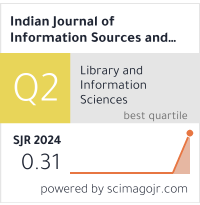Analyzing Demographic Influence, Usage and Availability of Electronic Resources among Baptist Theological Seminary Students, Ogbomoso, Nigeria
DOI:
https://doi.org/10.51983/ijiss.2017.7.2.472Keywords:
Demographic Influence, Theological Students, Electronic Resources (ER)Abstract
The primary aim of the study is to identify whether there are any significant or major differences among demographic variables such as gender, age group, faculty, usage and experience of users among the Baptist Theological Seminary student of Ogbomoso. The study adopted a descriptive survey research method. Questionnaires were used as the main instrument for data collection after a detailed literature review. The questionnaire was designed and distributed to 238 respondents in Nigerian Baptist Theological Seminary, Ogbomoso. The sampling method adopted for this study was Systematic Random Technique. The researcher made use of 238 and 207 were returned, given a response rate of 87.0%. Simple percentage was used to analyze the collected questionnaires through presentations of simplified tables. The findings revealed that there was significant relationship between availability of electronic resources and utilization of electronic library resources. Demographic factors were also analyzed to see if it has effect on usage of electronic library resources. There was no significant relationship between gender and use of electronic library resources though the respondents were more of males. The internet, e-journals and other electronic resources were important sources of information for the students. Majority of users centered their usage of electronic resources on Internet usage only. Students’ demographic factors should not be a barrier to e-resources use and as a result, students of all ages and gender should endeavor to acquire knowledge required to enable them make effective use of online library resources anytime and anywhere. Both young and old students should be encouraged and sensitized on the benefits available in the use of library electronic resources. The great majority of the faculties use printed sources more than e‐sources, but they also use e‐sources quite frequently. Use is mostly of books, websites and printed journals. It was also found that the use of e‐resources is higher in some faculties than others and also, the results indicated that the use of e‐resources is positively influenced by the respondents’ perceived usefulness of resources, the convenience of access to the sources and their academic productivity. This study would hopefully benefit the academicians, researchers, policy makers, and practitioners that has interest on electronic library resources and demographic related data.
References
Akman, L., & Rehan, E. (2010). Wired woman: gender and new realities in cyberspace. Convergence: The International Journal of Research into New Media.
Akman, İ., & Rehan, M. (2010). The predictive impact of socio-demographic and economic factors on internet usage of academics. Scientific Research and Essays, 5(14), 1890-1898.
Agyeman, O. T. (2007). ICT for Education in Nigeria, survey of ICT and education in Africa: Nigeria country report. Retrieved December 19, 2013, from www.infodev.org
Alli, & Naushad. (2005). The use of electronic resources at IIT Delhi Library: a study of search behaviours. The Electronic Library, 23(6), 691.
Bar-llan, J., Peritz, B. C., & Wolman, Y. (2003). A survey of the use of electronic databases and electronic journals accessed through the web by the academic staff of Israeli universities. Journal of Academic Librarianship, 29, 346-361.
Choudrie, J., & Dwivedi, Y. K. (2005). Investigating the research approaches for examining technology adoption issues. Journal of Research.
Choudrie, J., & Dwivedi, Y. K. (2005). The Demographics of Broadband Residential Consumers of a British Local Community: The London Borough of Hillingdon. Journal of Computer Information Systems, 45(4), 93-101.
Connell, T. H., Rogers, S. A., & Diedrichs, C. P. (2005). OhioLINK electronic journal use at Ohio State University portal. Libraries and the Academy, 5, 371-390.
Dadzie, P. S. (2005). Electronic Resources: access and usage at Ashesi University College. Campus-wide Information Systems, 22(5). Retrieved from http://www.emeraldinsight.com
Eason, D. L. (2004). New Journalism, Metaphor and Culture. Version of Record online: 5 MAR 2004.
Swain, K. D., & Panda, K. C. (2009). Use of electronic resources in business school libraries of an Indian state: A study of librarians' opinion. The Electronic Library, 27(1), 74-85.
Gakibayo, A., Ikoa-Odongo, J. R., & Okello-Obura, C. (2013). Electronic information resources utilization by students in Mbarara University Library. Library Philosophy and Practice (e-journal). Retrieved from http://digitalcommons.unl.edu/libphilprac/869
Madden, G., & Savage, J. S. (2000). Telecommunications and economic growth. International Journal of Social Economics, 27(7/8/9/10), 893-906.
Graham, S. (2003). Learner strategies and advanced level listening comprehension. Language Learning Journal, 28(1), 64-69.
Hassani, S. N. (2006). Locating digital divides at home, work, and everywhere else. Poetics, 34, 250-272.
Jagboro, K. O. (2003). A survey of internet use in Nigeria universities. A case study of Obafemi Awolowo University, Ile-Ife, Nigeria. Journal of Academic Librarianship, 30(4), 322-327.
Le Cornu, A. (2008). Teaching practical theology using reusable electronic learning objects: practical, educational, and theological challenges. Journal of Adult Theological Education, 5(1), 71-85.
Lernhart, & Horrigan. (2003). Revisualising the Digital Divide as a digital spectrum. IT and Society, 1(5), 23-29.
Longman Dictionary of English. (2007).
Markauskaite, L. (2005). Exploring differences in trainee teachers' ICT literacy: does gender matter? In H. Goss (Ed.), Balance, Fidelity, Mobility: Maintaining the Momentum? Proceedings of the 22nd Annual Conference of the Australasian Society for Computers in Learning in Tertiary Education (pp. 445-455). Brisbane: Teaching and Learning Support Services, Queensland University of Technology.
Odewale. (2015). 2015 annual report - Bowen University.
Ojo, R. A., & Akande, S. O. (2005). Students access, usage, and awareness of electronic information resources at the University College Hospital, University of Ibadan, Nigeria. Lagos Journal of Library and Information Science, 3(1), 16-24.
Okiki, O. C., & Asiru, S. M. (2011). Use of Electronic Information Sources by Postgraduate Students in Nigeria: Influencing Factors. Library Philosophy and Practice (e-journal), Paper 500. Retrieved June 20, 2013, from http://digitalcommons.unl.edu/libphilprac/500
Palmer, J. P., & Sandler, M. (2003). What Do Faculty Want? Netconnect (Winter), 26-28.
Salaam, M. O. (2007). Options for access to journals, print, CD-Rom, online in a Nigerian Agricultural University Library. Samaru Journal of Information Studies, 7(2), 24-27.
Reitz, J. M. (2004). Dictionary for library and information science. Includes bibliographical references. London: Libraries Unlimited, 24.
Shapka, J. D., & Ferrari, M. (2003). Computer-related attitudes and actions of teacher candidates. Computers in Human Behavior, 19(3), 319–334.
Shukla, S. S., Singh, K. A. P., & Mishra, A. K. (2013). The Role of Libraries in Literacy and Education, Pre-Requisite For Education & Sustainable Development at All Levels of Education. IOSR Journal Of Humanities And Social Science (IOSR-JHSS), 14(5), 35-40.
Swain, D. K. (2009). Use of electronic resources in business school libraries of an Indian state: A study of librarians’ opinion. Electronic Library, 27(1), 74-85.
Taylor, W., Zhu, G., Dekkers, J., & Marshall, S. (2003). Socio-economic factors affecting home internal usage patterns in central Queensland. Information Science Journal, 6, 233-246.
Tenopir, C. (2003). Use and users of electronic library resources: An overview and analysis of recent research studies. Council on Library and Information Resources. Retrieved July 24, 2013, from www.clir.org/pubs/reports/pub120/pub120.pdf
Tompsett, C., & Alsop, G. (2003). On reification: A reinterpretation of designed and emergent practice. Association for Learning Technology Journal, 11(2), 61-63. ISSN 0968-7769.
Young, P. R. (2001). Electronic services and library performance measurement: A definitional challenge. Paper presented at the 4th International Conference, Northumbria.
Downloads
Published
How to Cite
Issue
Section
License
Copyright (c) 2017 The Research Publication

This work is licensed under a Creative Commons Attribution-NonCommercial-NoDerivatives 4.0 International License.









